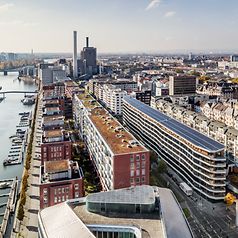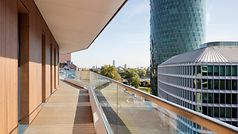Aktiv-Stadthaus, Frankfurt
Innovative façade generates solar power
Situated near Frankfurt's Westhafen district and completed in July 2015, the Aktiv-Stadthaus is the world's largest and first energy-plus building of its kind. The eight-storey building provides space for 74 barrier-free rental apartments measuring between 60 and 120 m2 and featuring balconies and loggias. It also generates more energy each year than its residents need. A sophisticated energy concept combined with an innovative façade are the secret recipe behind the apartment block of the future.





Facts and figures
Location: Frankfurt am Main, Germany
Design/construction period: 2012-2015
Gross floor space: 11,700 m²
Schüco systems: FW 50+ SI including SG solution
Architect: HHS Planer + Architekten AG
Investor: ABG FRANKFURT HOLDING Wohnungsbau- und Beteiligungsgesellschaft mbH


Style meets energy efficiency
From a bird's-eye view, the 150-metre-long, 10-metre-wide Aktiv-Stadthaus looks like a surfboard about to catch a wave. With its 27-metre-high building structure, the light-grey spandrels measuring just 50 cm high, the gently curving photovoltaic façade and the sloped mono-pitch roof, the building defies the stereotype of a low-energy house, looking much more airy and delicate. Of course, in addition to its stylish appearance and high-quality finish, the Aktiv-Stadthaus also features a future-proof energy concept. The suspended, rear-ventilated façade from Schüco, with its photovoltaic units, plays a key role in this.
Façade collects sun's rays
The photovoltaic modules were combined with the technically and architecturally high-quality Schüco FW 50+ façade system, which has been tried and tested millions of times, with a semi-structural glazing look, executed in a mullion and transom construction with a narrow profile face of just 50 millimetres, in order to make the building as slender as possible. In addition, the environmental compatibility of the materials was a major factor in the planners' and clients' decision to use this type of construction. About 290,000 kilowatt hours of solar energy are generated annually via the roof and the façade - this not only covers the consumption of all 74 households for heating, hot water, lighting, household appliances, operating equipment (e.g. lift) and e-mobility, but even results in a surplus of about 27,000 kilowatt hours per year, which can be temporarily stored as a reserve.


DGNB certified: good for the climate
What's more, the energy required for heating and hot water is generated by means of a heat pump, which uses waste heat from a sewer as its heat source. As the power requirements for each household are an important part of the overall energy requirements, the apartments are fitted with appliances that have the highest efficiency ratings.
This pioneering energy concept meant that the Aktiv-Stadthaus was awarded the certificate "climate-positive" by the German Sustainable Building Council (DGNB). This certificate recognises particularly sustainable buildings that make a significantly positive contribution to climate protection by having a negative annual carbon footprint.
